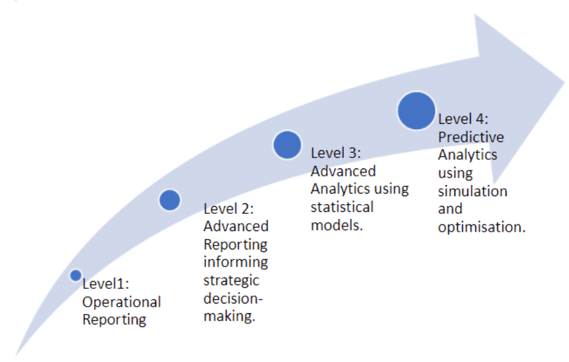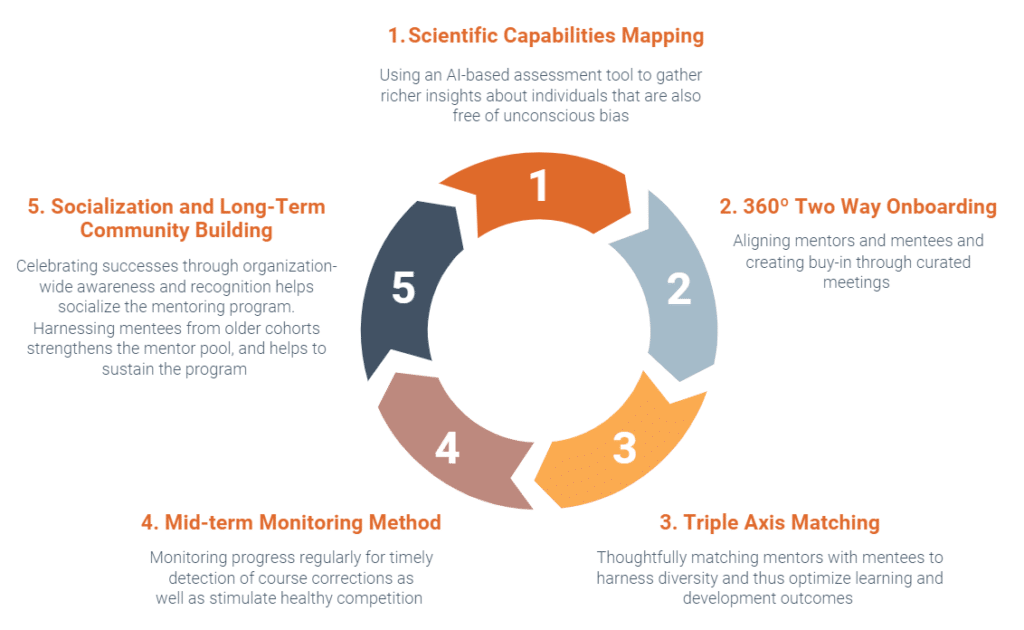Thoughtfully-Designed and Curated Mentoring Programs Deliver Tangible Outcomes
Organizations increasingly recognize the linkage between Mentoring, Diversity & Inclusion (D&I), Employee Engagement, Retention and Performance.
Philip Morris, for example, experienced encouraging results within three months of launching a structured mentoring program. Employee engagement went up, there was visible improvement in collaboration, and employee promotability increased by 25%! Philip Morris is on a journey of enterprise transformation to prepare itself for success in the new era. The company seeks to shift away from tobacco products, while also embracing digitalization.
Both these transformation vectors need new ways of thinking and doing. In this context, the company’s leaders wanted 16 “top talents” from the IT team (Vice Presidents down to Senior Managers) to be exposed to “external perspectives”. In order to do this, they enrolled these 16 IT executives in a mentoring program. Taking both a top-down and bottom-up view, the program was designed to provide the 16 mentees with:
- Enhanced self-awareness to give them a better understanding of their strengths and where they can easily excel and where they need to develop to be more effective;
- Exposure to different leadership types and working styles; and
- Opportunities to develop perspectives around future IT leadership

An initial assessment of the 16 mentees helped identify each individual’s strengths as well as potential development areas. Through a scientific process of capabilities matching (elaborated in a later section), the mentees were assigned to 16 specially-chosen mentors.
The positive outcomes of the mentoring program were acknowledged by the program’s sponsors. Participants also articulated the usefulness of mentorship and its impact on them. Giovanni Vassallo, Manager Information Security for Operations, said, “My Mentor was of great support for such an introspective experience, which eventually translated into a new routine that enabled me to unleash my potential”.
Studies have proved that curated mentoring programs boost employee engagement, loyalty and performance. A study by Cornell University’s School of Industrial and Labor Relations found that mentoring programs also boosted minority representation at the management level by 9% compared to other diversity initiatives that actually caused a 2% drop. The same study also found that mentoring programs improved promotion and retention rates for minorities and women by 15% to 38% respectively as compared to non-mentored employees.
Other companies in the consumer products space, also have experienced the positive correlation between mentoring programs and tangible business benefits. Following a mentoring intervention, GHD, the UK-based hair products company, reported increased self-confidence and improved influencing skills in 100% of the mentees.

As Melissa McClure, Global Talent Acquisition & Development Manager, GHD put it, “Across the board, we’re seeing the
mentees articulating their ideas with more confidence and speaking up about issues of importance to the organization. There is clearly a greater sense of inclusivity, as people feel that they have a say in evolving the business”.
Asked about the impact of structured mentoring programs, Inés Franke, Senior Director of Commercial Strategy at Kellogg’s and a mentor with LS Elevate, had this to say: “LS Elevate’s approach enables very open and transparent conversations away from any internal politics, and brings fresh, new, outside-in perspectives that both parties can benefit from”.
The reason why many mentoring programs have failed
Many D&I programs fail to deliver significant or tangible outcomes due to the absence of a coherent structure and because they lack stakeholder buy-in, the right pool of mentors, sustained advocacy and celebration of successes. Such programs are most often powered by the personal initiative of people with a passion for development; when these key individuals change roles or leave the organization, the efforts tend to fizzle out. Worse, the programs need to be built again from scratch, because there is no institutional foundation left to support it.
We at LS International have mapped out the main pillars needed to build an effective mentoring program that delivers on both L&D and D&I goals. The clearly-enunciated steps make our approach easily scalable across organizations, including across multiple BUs and geographies. Our approach to designing and delivering mentoring programs makes it easy for organizations to institutionalize them. This enhances sustainability and significantly improves the odds of achieving not just targeted L&D and D&I outcomes, but also the organization’s overall business performance. Our step-by-step method, created by LS Elevate, helps organizations to institutionalize mentoring capabilities, build competencies, and celebrate successes to socialize the importance of mentoring across the enterprise which brings benefits in terms of performance (individuals and business) as well as D&I progression.
The core objective is to make it easier for HR teams to gain maturity in running mentoring programs. A second objective is to enable D&I enhancement via a core HR process that can easily be linked with other competency development and leadership programs.
What is LS Elevate?
LS Elevate is our Leadership Development division. It is born out of Lauren Stiebing’s vision that future leaders need to be equipped to face a very different set of emerging challenges in an environment of rapid change. Our mentoring and other leadership development programs are designed to deliver interactive, practical, flexible and agile support to help executives reach positions at the Board level. The kind of support executives need to progress it also reflects the level of support that is often absent!
LS Elevate’s 5 pillars to structure a mentoring program
The LS Elevate approach to delivering a structured mentoring program involves five distinct pillars. In the light of current imperatives, opportunities and constraints, these make the mentoring journey more outcomes-focused as well as enriching for both mentees and their organizations.
We summarize below each of the five steps; for each one we highlight how LS Elevate’s approach is different from the conventional mentoring program.
1. Scientific Capabilities Mapping:
Earlier, HR managers would rely on subjective feedback from a mentee’s manager to identify development needs and a plan. This increased the risk of unconscious bias due to the manager’s personal views and the relationship with the mentee creeping into the assessment- and thus subsequent development efforts. Often, managers would provide feedback without spending much time on thinking through; this can lead to recency bias or reliance on anecdotal evidence.
Our approach uses AI-based tools to identify strengths, gaps and developmental areas. This process is not only faster, but also more reliable and accurate. Also, tools provide powerful insights not just into an individual’s behavioural strengths and preferences, but also predictive linkages with their on the-job performance. The tool enhances the process of matching mentees with mentors because it eliminates all unconscious biases.
In a 2019 article titled “Big Data and Human Resources Management: The Rise of Talent Analytics”, authors Manuela Nocker and Vania Sena of Essex University pointed out that “The key contribution of talent analytics to value creation is in the fact that it allows one to exploit individual-level data and help design measures that can support employees in a personalized way”.
The paper refers to Josh Bersin’s Talent Analytics function to talk about the 4 levels of maturity. Our experience suggests that in terms of their Talent Analytics maturity, most companies are currently between levels 2 and 3. Using Big Data and AI tools can help them advance further.

2. 360º Two-Way Onboarding:
Traditional mentoring approaches have generally lacked a formal process for onboarding mentors and mentees. At best, introduction emails would be sent, along with a list of dos and don’ts. Many executives do not fully appreciate the difference between mentoring and coaching. All this has typically led to mismatched expectations, in turn causing unhappy experiences and sub-optimal results.
We believe that both mentors and mentees need to be onboarded so that they develop a shared understanding of the path ahead. The correct approach to mentoring must be designed and delivered to ensure that there is a complete understanding of what mentoring is, how it works, and what mentees and mentors) should (and should not) expect. To achieve this, companies should have separately-held interactive sessions with both mentors and mentees. These sessions are used to articulate expectations, clarify roles and responsibilities and provide a broad view of the process ahead. The sessions help mentees and mentors in setting goals, frequency of sessions, progress indicators and milestones. At these sessions, people who have undergone mentoring earlier can share their experiences and learnings. This is also a forum for mentees and mentors to ask questions and seek clarifications.
A best practice handbook capturing the key points from the above sessions is compiled and shared with all mentors and mentees so that everyone is on the same page. This is thus a critical step that helps make the mentoring journey smoother and more enriching.
3. Triple Axis Matching:
Traditionally, mentors were assigned based only on their availability, experience or shared interests. Either the HR team did this or employees used a technology platform to select mentors. Elevated performance and results come from an approach to matching mentors and mentees that goes beyond interests, experience or availability. To achieve outstanding results, the matching should be based on three distinct axes:
- Country/continent/culture
- Functional and market expertise
- Academic backgrounds
This creates greater “inclusion and diversity” in assigning mentees to mentors. It also pushes individuals outside their comfort zones, which we believe is essential to move the needle in development interventions. This is also why Reverse mentoring is often helpful in bridging intergenerational gaps- a key challenge for many organizations in the current environment.
4. Mid-term Monitoring:
Like any other organizational development interventions, mentoring programs also need to be monitored regularly so that course-corrections can be made as and when necessary. It is vital to ensure that both mentors and mentees stay engaged and committed to each other and to the journey.
The right approach gives mentees periodic opportunities to showcase how they have applied their learnings to their work to others in their cohort. This allows mentee to share key learnings which serves to motivate both mentors and mentees. This is also a way for the organization to assess “performance” of mentors. Ultimately, the organization benefits in many ways.
5. Socialization and Long-Term Community Building:
In many organizations, mentoring is not widely used across the enterprise. Embedding mentoring into the core of HR requires a number of examples of success to be showcased across the entire organization. Also, mentoring needs to be adopted as a sustained program. This requires an adequate pool of experienced and motivated mentors capable of supporting freshly-promoted managers as well as lateral hires.
The LS Elevate approach is designed to address both these needs. Organizations are encouraged to publicize mentoring success stories using videos, newsletters or virtual events. Mentors who have made a difference to their mentees and enabled them to elevate their individual/team/business
performance are recognized. This is a powerful- and inclusive- way to signal the importance the organization attaches to mentoring programs.
The established way of creating a pool of mentors relied on using existing mentors or bringing on board retired executives. This can be limiting. Our approach proactively expands the mentor pool and strengthens its diversity by including mentees from earlier cohorts as well the infusion of external
insight and energy that our pool of external mentors brings. Having personally gained from the program, they are more likely to be natural advocates and cheerleaders. Their insights are useful to tweak the contours of the program to further enhance its effectiveness
Summary:
Summarized below are the five steps of the LS Elevate approach to deliver structured mentoring programs that can be used to achieve a number of outcomes including D&I enhancement.
- Scientific capabilities mapping: Using an AI-based assessment tool to gather richer insights about
individuals that are also free of unconscious bias. - 360º Two Way Onboarding: Aligning mentors and mentees and creating buy-in through curated
meetings. - 3 Axis Matching Method: Thoughtfully matching mentors with mentees to harness diversity and
thus optimize learning and development outcomes. - Mid-term Monitoring Method: Monitoring progress regularly for timely detection of course
corrections as well as stimulate healthy competition. - Socialization and Long-Term Community Building: Celebrating successes through organization-wide awareness and recognition helps socialize the mentoring program. Harnessing mentees from
older cohorts strengthens the mentor pool, and helps to sustain the program.
In particular, it is this more truly inclusive approach that enables the enhanced level of diversity to flourish.

What you must do to launch your mentoring program
Putting in place and sustaining a robust mentoring program requires time and effort. The major tasks that need to be performed efficiently and effectively to build, roll-out and sustain a world-class mentoring program are listed below:
- Find an assessment that provides objective data.
- Build the right program and methodology.
- Create the necessary resources
- Build your pool of top mentors
- Selection of mentees
- Conduct assessments, analyzing the results and delivering feedback
- Alignment meetings with mentees and their line managers
- Quarterly catch-ups with individual mentees and mentors (Separately)
- Progress tracking
- Internal storytelling
- Networking events
- Building a long-term community of mentors within the organization
All the above can be done in-house; depending on the size of your organization and the scale of the mentoring program envisioned, you will probably need about 4 full time employees to do/manage the above-mentioned tasks. Organizations that have adopted a hybrid model of mentoring (using internal
and external mentors) have seen better results. This is because mentees get exposure to in-house and external perspectives on leading change, market trends, etc. The choice of an “in” or “out” mentor can reflect the mentees’ development needs.
Done right, mentoring programs can help your executives acquire new perspectives and insights, learn new leadership techniques and above all, help unlock your organization’s creative energies to respond more effectively to the rapid changes unfolding all around.
You can do it yourself (but we’re there to help)
External advice and assistance are not necessarily required to construct and execute mentoring programs, but third-party expertise and experience certainly helps in ensuring that:
- The right mentors are identified.
- Both mentors and mentees are committed to the journey and each other and stay engaged
over the duration of the mentoring program. - The right outcomes are targeted and achieved.
- A strong foundation for sustaining mentoring as a core HR process is laid by developing the
requisite capabilities and making the larger organization aware of successes.
Are you ready for the ride?
If you are unsure about where or how to start or do not have the resources to spare, please write us an email (info@ls-international.com) or call Lauren Stiebing on +34 931 760 239. LS International’s experts will be happy to discuss your organization’s unique mentoring needs and explore how LS Elevate can potentially help.
By Lauren Stiebing, Founder of LS International

